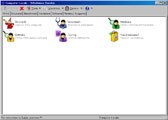Mass Effect Andromeda Game GiveAway Rules OF GiveAway: You Must Be Subbed To The Channel And Leave A Comment Here, FB and Twitter For 3 Chances To Win! Subscribe! http://bit.ly/SubTechofTomorrow Mass Effect Andromeda
http://amzn.to/2nNYk17 Mass Effect Andromeda 1800X & GTX 1080 Ti 4K Gameplay
http://bit.ly/2mxnq3L How Does A Ryzen 1800X & RX 480 Play Mass Effect Andromeda?
http://bit.ly/2ncKiTs Try Amazon Prime FREE for 30 Days & Support Tech of Tomorrow! http://amzn.to/12JFYau Don't forget to check out the website!
http://www.techoftomorrow.com Check us out on Facebook!
http://www.facebook.com/TechofTomorrow Stay updated on Twitter!
http://www.twitter.com/techof_tomorrow Tech of Tomorrow Music!
http://www.techoftomorrow.com/music The Benchmark Song: The Human Zoo
– Free on Spotify! http://spoti.fi/10Vz31z
– Amazon: http://amzn.to/12Rh6kI
– iTunes: http://bit.ly/199301I
Categoria: HardwareSoftware

Google e Symantec ai ferri corti: Chrome potrebbe presto indicare come non validi tutti i certificati SSL/TLS emessi da Symantec. Ecco perché.
Symantec, che in precedenza aveva acquisito VeriSign, pezzo da novanta per quanto riguarda le attività di certificazione dell’identità online, è nell’occhio del ciclone.
Secondo le ultime statistiche di Netcraft, Symantec è responsabile dell’emissione di un terzo dei certificati SSL complessivamente utilizzati a livello mondiale sui siti web.
Eppure, i responsabili di Google hanno dichiarato di aver perso fiducia nel ruolo di certification authority ricoperto da Symantec e l’azienda di Mountain View starebbe seriamente valutando di dichiarare inaffidabili i certificati digitali da essa firmati.

Google potrebbe non riconoscere più neppure la validità dei certificati EV-SSL (extended validation) ovvero quelli che offrono una maggiore sicurezza sull’identità del sito web visitato (la barra degli indirizzi del browser si colora di verde nella parte iniziale e indica esplicitamente il nome del detentore del certificato).
Per approfondire, suggeriamo la lettura dell’articolo Sito sicuro su Chrome e Firefox, che cosa significa.
Google motiva la sua decisione draconiana sulla base di ripetuti incidenti che hanno coinvolto Symantec: la società, infatti, non avrebbe verificato in modo approfondito l’identità dei richiedenti alcuni certificati digitali.
Se Google dovesse “passare ai fatti”, presto Chrome potrebbe non riconoscere come validi i certificati SSL/TLS di Symantec e indicare come Non sicuri i siti web che ne fanno uso.
Symantec ha bollato il comportamento di Google come un “atto irresponsabile” aggiungendo che “si augura che le informazioni apparse online non siano state diffuse per ingenerare incertezza e dubbi rispetto ai certificati digitali emessi dall’azienda“.
Autore: IlSoftware.it
SiSoftware Sandra Lite 2017
scheda aggiornata 31 minuti fa
Descrizione
Versione 2015 del popolare tool diagnostico e di benchmarking del proprio sistema. Qui di seguito le principali novità introdotte:
* Support for Windows 10* Tech Preview
– Updated to the latest tools & libraries for forthcoming Windows 10, with various minor compatibility changes and support for new APIs, technologies as well as hardware.
– Will support DirectX 12.
– Support for very-wide SIMD AVX-512 family.
– Updated resources for high-DPI (retina+) up to 200% 192ppi or higher – e.g. huge 256×256 icons.
* Updated System benchmark: Overall Score 2015
– Removed .Net/Java Multi-Media (vectorised) benchmark as current JVM/CLR do not vectorise even today.
– Added CPU Scientific (GEMM, FFT, N-Body), CPU Financial (Binomial, Monte Carlo, Black-Scholes) Analysis – while GPGPUs do accelerate these complex algorithms, wide-SIMD (e.g. AVX-512F) can significantly accelerate them in large CPUs with many cores and large caches (e.g. 12C+ 24MB L3/128MB L4)
– Added GP Scientific Analysis (GEMM, FFT, N-Body) (using CUDA, OpenCL, DirectX Compute) – to match CPU Scientific
– Updated weights to match modern devices (mobile, laptop, desktop and server)
* Updated Crytography CPU Benchmark
– Optimised AES HWA code-path for improved performance across hardware constrained by memory bandwidth.
* Optimised GP Benchmarks
– GP Cryptography – optimised AES code-path.
– GP Scientific – optimised N-Body path.
– GP Financial – optimised Binomial Options path.
* Updated CPU Multi-Media (SIMD) Benchmark
– Combined score is now made of “combined integer (int32 and int64)” and “combined floating-point (single and double)” SIMD performance. Sandra 2014 used “int32 single-float and double-float” only.
– Combined integer averages int32 (32-bit integer) and int64 (64-bit integer) SIMD performance (SSE, SSE2, AVX, AVX2) – and thus measure also 64-bit integer performance that is extensively used today.
– int128 (quad-integer emulated) and quad-precision float-point (emulated, mantissa precision extended) is also measured but not included in the index as both are emulated at this time. Once native SIMD support is available in hardware, they will be added to the index.
* Updated Memory Bandwidth Benchmark
– Now reports average (rms – root mean sqare) not maximum performance. Some scores *will* be lower depending on the hardware, usually 3-5%. You can use the “maximum value” as index if you want to match Sandra 2014 and earlier.
* Updated Cache & Memory Bandwidth Benchmark
– Now reports average (rms – root mean sqare) not maximum performance. Some scores *will* be lower depending on the hardware, usually 5-20%. You can use the “maximum value” as index if you want to match Sandra 2014 and earlier.
Autore: Le news di Hardware Upgrade

La Commissione UE ha acceso i riflettori sui finanziamenti di Stato previsti dai bandi Infratel.
Readying to support Windows Mixed Reality headsets in Q4
ASUS has recently announced that it is readying to spin off its augmented reality and virtual reality development teams to become an independent startup, according to the latest Far East reports.
In a turn of events characterized by a fashion-forward brand name, the company has decided to name its independent startup “Glamorfy” and has been allowed to operate independent as Glamorfy Taiwan. The new startup was previously a development unit of ASUS’ human machine interface (HMI) software department and has since rolled out a number of AR and VR products – including a 3D VR makeup design studio for cosmetic purposes, complete with integrated Voice-over-IP support.
For at least the past year, Glamorfy Taiwan has been participating in the development of augmented reality (AR) and mixed reality (MR) devices, including the upcoming ASUS Windows Mixed Reality headset that will debut later in the fourth quarter of 2017. The new head-mounted displays will be accompanied by custom ASUS software supporting the devices, and will likely offer a more extensive driver suite with a selection of demos and featured software applications to choose from.
Over the next few months, the company’s independent AR/VR startup unit plans to obtain a series of investments from several potential investors to expand its operations and research outlook. This will hopefully lead to an eventual spinoff from the parent company.
ASUS is currently Taiwan’s largest IT hardware manufacturer, and its Hi-Tech Park located in Suzhou, China covers nearly 540,000 square meters (5.8 million square feet), or roughly the size of eighty-two soccer fields. Surely it has enough room to spin off its wearable headset division while maintaining a sizable portion of its HMI software department.
Autore: Fudzilla.com – Home


